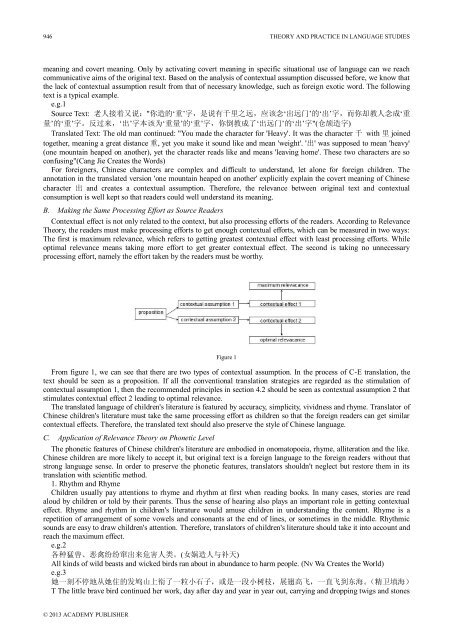Theory and Practice in Language Studies Contents - Academy ...
Theory and Practice in Language Studies Contents - Academy ...
Theory and Practice in Language Studies Contents - Academy ...
You also want an ePaper? Increase the reach of your titles
YUMPU automatically turns print PDFs into web optimized ePapers that Google loves.
946 THEORY AND PRACTICE IN LANGUAGE STUDIESmean<strong>in</strong>g <strong>and</strong> covert mean<strong>in</strong>g. Only by activat<strong>in</strong>g covert mean<strong>in</strong>g <strong>in</strong> specific situational use of language can we reachcommunicative aims of the orig<strong>in</strong>al text. Based on the analysis of contextual assumption discussed before, we know thatthe lack of contextual assumption result from that of necessary knowledge, such as foreign exotic word. The follow<strong>in</strong>gtext is a typical example.e.g.1Source Text: 老 人 接 着 又 说 :" 你 造 的 „ 重 ‟ 字 , 是 说 有 千 里 之 远 , 应 该 念 „ 出 远 门 ‟ 的 „ 出 ‟ 字 , 而 你 却 教 人 念 成 „ 重量 ‟ 的 „ 重 ‟ 字 。 反 过 来 ,„ 出 ‟ 字 本 该 为 „ 重 量 ‟ 的 „ 重 ‟ 字 , 你 倒 教 成 了 „ 出 远 门 ‟ 的 „ 出 ‟ 字 "( 仓 颉 造 字 )Translated Text: The old man cont<strong>in</strong>ued: "You made the character for 'Heavy'. It was the character 千 with 里 jo<strong>in</strong>edtogether, mean<strong>in</strong>g a great distance 重 , yet you make it sound like <strong>and</strong> mean 'weight'. ' 出 ' was supposed to mean 'heavy'(one mounta<strong>in</strong> heaped on another), yet the character reads like <strong>and</strong> means 'leav<strong>in</strong>g home'. These two characters are soconfus<strong>in</strong>g"(Cang Jie Creates the Words)For foreigners, Ch<strong>in</strong>ese characters are complex <strong>and</strong> difficult to underst<strong>and</strong>, let alone for foreign children. Theannotation <strong>in</strong> the translated version 'one mounta<strong>in</strong> heaped on another' explicitly expla<strong>in</strong> the covert mean<strong>in</strong>g of Ch<strong>in</strong>esecharacter 出 <strong>and</strong> creates a contextual assumption. Therefore, the relevance between orig<strong>in</strong>al text <strong>and</strong> contextualconsumption is well kept so that readers could well underst<strong>and</strong> its mean<strong>in</strong>g.B. Mak<strong>in</strong>g the Same Process<strong>in</strong>g Effort as Source ReadersContextual effect is not only related to the context, but also process<strong>in</strong>g efforts of the readers. Accord<strong>in</strong>g to Relevance<strong>Theory</strong>, the readers must make process<strong>in</strong>g efforts to get enough contextual efforts, which can be measured <strong>in</strong> two ways:The first is maximum relevance, which refers to gett<strong>in</strong>g greatest contextual effect with least process<strong>in</strong>g efforts. Whileoptimal relevance means tak<strong>in</strong>g more effort to get greater contextual effect. The second is tak<strong>in</strong>g no unnecessaryprocess<strong>in</strong>g effort, namely the effort taken by the readers must be worthy.Figure 1From figure 1, we can see that there are two types of contextual assumption. In the process of C-E translation, thetext should be seen as a proposition. If all the conventional translation strategies are regarded as the stimulation ofcontextual assumption 1, then the recommended pr<strong>in</strong>ciples <strong>in</strong> section 4.2 should be seen as contextual assumption 2 thatstimulates contextual effect 2 lead<strong>in</strong>g to optimal relevance.The translated language of children's literature is featured by accuracy, simplicity, vividness <strong>and</strong> rhyme. Translator ofCh<strong>in</strong>ese children's literature must take the same process<strong>in</strong>g effort as children so that the foreign readers can get similarcontextual effects. Therefore, the translated text should also preserve the style of Ch<strong>in</strong>ese language.C. Application of Relevance <strong>Theory</strong> on Phonetic LevelThe phonetic features of Ch<strong>in</strong>ese children's literature are embodied <strong>in</strong> onomatopoeia, rhyme, alliteration <strong>and</strong> the like.Ch<strong>in</strong>ese children are more likely to accept it, but orig<strong>in</strong>al text is a foreign language to the foreign readers without thatstrong language sense. In order to preserve the phonetic features, translators shouldn't neglect but restore them <strong>in</strong> itstranslation with scientific method.1. Rhythm <strong>and</strong> RhymeChildren usually pay attentions to rhyme <strong>and</strong> rhythm at first when read<strong>in</strong>g books. In many cases, stories are readaloud by children or told by their parents. Thus the sense of hear<strong>in</strong>g also plays an important role <strong>in</strong> gett<strong>in</strong>g contextualeffect. Rhyme <strong>and</strong> rhythm <strong>in</strong> children's literature would amuse children <strong>in</strong> underst<strong>and</strong><strong>in</strong>g the content. Rhyme is arepetition of arrangement of some vowels <strong>and</strong> consonants at the end of l<strong>in</strong>es, or sometimes <strong>in</strong> the middle. Rhythmicsounds are easy to draw children's attention. Therefore, translators of children's literature should take it <strong>in</strong>to account <strong>and</strong>reach the maximum effect.e.g.2各 种 猛 兽 、 恶 禽 纷 纷 窜 出 来 危 害 人 类 。( 女 娲 造 人 与 补 天 )All k<strong>in</strong>ds of wild beasts <strong>and</strong> wicked birds ran about <strong>in</strong> abundance to harm people. (Nv Wa Creates the World)e.g.3她 一 刻 不 停 地 从 她 住 的 发 鸠 山 上 衔 了 一 粒 小 石 子 , 或 是 一 段 小 树 枝 , 展 翅 高 飞 , 一 直 飞 到 东 海 。( 精 卫 填 海 )T The little brave bird cont<strong>in</strong>ued her work, day after day <strong>and</strong> year <strong>in</strong> year out, carry<strong>in</strong>g <strong>and</strong> dropp<strong>in</strong>g twigs <strong>and</strong> stones© 2013 ACADEMY PUBLISHER
















